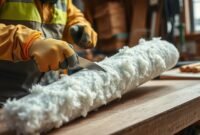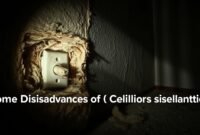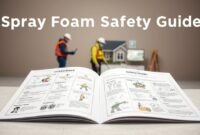As a homeowner, I’ve been curious about spray foam insulation’s energy-saving claims. But, I’ve found out it has its downsides, like roof damage and health risks. It’s key to know these issues before deciding on this insulation.

Key Takeaways
- Spray foam insulation can last up to 80 years, but it comes with various roof-related issues.
- Closed-cell spray foam can cause roof damage due to expansion and contraction, affecting structural integrity.
- Spray foam insulation has a high Global Warming Potentia, posing environmental concerns.
- Improper installation can lead to health problems, lingering odors, and mold growth.
- Alternative insulation options, such as HempWool®, offer eco-friendly and safer solutions.
Understanding Spray Foam Insulation: Benefits and Drawbacks
Spray foam insulation is a top pick for those wanting to keep their homes warm or cool. It comes in two main types: closed-cell and open-cell. Knowing the differences between them is key when choosing insulation for your home.
Types of Spray Foam Insulation
Closed-cell spray foam is the better insulator. It seals tighter and has a higher R-value than open-cell foam. This makes it great for roofs and walls where energy efficiency is a must.
Open-cell spray foam, on the other hand, lets moisture and air through. It’s cheaper and works well in attics.
Read also: Spray Foam That Mice Won’t Eat
How Spray Foam Insulation Works
Spray foam creates a tight seal to stop heat, air, and moisture from moving. It’s applied as a chemical mix that expands to fill gaps. This can save a lot of energy, cutting costs by up to 50% in some cases.
Installation Process Overview
Installing spray foam needs special tools and experts. The foam is sprayed on, expanding and hardening to form a solid layer. But, if not done right, it can shrink, lose effectiveness, or even harm the building.
Before choosing spray foam insulation, weigh its pros and cons. Also, make sure the installer knows what they’re doing. This ensures your home stays comfortable for years to come.
Environmental Impact and Sustainability Concerns
As someone who cares about the planet, I always think about the products I buy. Spray foam insulation is great for saving energy and sealing air leaks. But, it also raises some big environmental worries.
Traditional spray foam often uses materials that aren’t good for the planet. It also has blowing agents that harm the environment. For example, HFC-245fa has a high Global Warming Potentia (GWP) of 1030. But, the industry is moving towards better options like HFOs, which have a much lower GWP of about 1.
Another problem is that spray foam is hard to recycle because it sticks to things. This means it often ends up in landfills. It’s hard to get rid of without damaging the materials underneath.
Read also: How to Get Spray Foam Off Hands Quickly?
| Insulation Type | Global Warming Potentia (GWP) |
|---|---|
| Closed-cell spray foam (HFC-blown) | 1030 |
| Closed-cell spray foam (HFO-blown) | 1 |
| Cellulose | – |
| Wood fiber | – |
The industry is trying to make spray foam more eco-friendly. They’re looking at options like cellulose and wood fiber. These materials are better for the planet and can be recycled more easily. By thinking about the long-term effects of our choices, we can pick options that save energy and are good for the environment.
Read also: How to Get Spray Foam out of Clothes

Spray Foam Insulation Roof Problems: Common Issues and Solutions
As a homeowner, knowing about spray foam insulation roof problems is key. Issues like moisture buildup and structural concerns need quick action to keep your home safe. Let’s look at common problems and find good solutions.
Moisture and Condensation Issues
Moisture buildup and condensation are big worries with spray foam insulation. Closed-cell foam is often at risk. When it expands and contracts, it can leave gaps, letting moisture in and harming wood.
Open-cell foam is a better choice. It’s more breathable, which helps prevent condensation problems.
Structural Integrity Concerns
Spray foam can also weaken your roof’s structure. Its expansion and contraction can create gaps and cracks. This weakens the roof decking.
To avoid this, make sure a pro installs the foam right. Follow the manufacturer’s instructions to keep your roof strong.
Installation-Related Problems
Bad installation is a big problem with spray foam. If it’s not done right, you might face condensation, air leaks, and health risks. Good ventilation and watching for problems are key to a healthy home.
Choose a trusted contractor for your roof. They’ll install it right and keep it in good shape. Regular checks and quick fixes are vital for your home’s safety and energy efficiency.
| Common Spray Foam Insulation Roof Problems | Solutions |
|---|---|
| Moisture and Condensation Issues | Use open-cell foam for better airflow and reduced condensation risk |
| Structural Integrity Concerns | Ensure proper installation by a professional following manufacturer guidelines |
| Installation-Related Problems | Maintain proper ventilation and regularly inspect for any issues |
Health and Safety Considerations
When installing spray foam insulation, health and safety are key. Spray foam can make your home more energy-efficient and cut down on costs. But, it’s important to know the risks.
Older spray foam products had harmful chemicals. These chemicals can cause serious health issues. They might lead to breathing problems, asthma, or even brain damage.
- Proper installation and evacuation procedures are key to avoid health risks.
- Don’t spray foam near electrical outlets or recessed lights to avoid damage.
- Professional installation and enough curing time are vital for safety.
Spray foam insulation should not block ventilation or airflow. This can lead to bad air quality. Always talk to a pro before installing spray foam insulation to make sure it’s safe and right for you.
By focusing on health and safety, you can enjoy spray foam insulation without risks. A bit of caution ensures a safe and successful installation.
Proper Maintenance and Inspection Guidelines
Keeping your spray foam roof insulation in good shape is vital. It helps keep your home or business energy-efficient and safe. Regular checks and maintenance are essential to ensure your insulation lasts long.
Regular Maintenance Checklist
- Do visual checks twice a year for cracks, holes, or damage.
- Make sure roof drains are clear and working right to avoid water issues.
- Put on a protective coating every 5 to 10 years to keep the roof shiny and protect it from UV rays.
- Try not to walk on the spray foam roof too much to avoid damage.
- Keep the roof clean to stop debris from harming the insulation’s performance.
Signs of Deterioration
Watch out for problems with your spray foam roof insulation and fix them fast. Look out for:
- Cracks, holes, or other damage on the spray foam.
- Strange smells or changes in how the insulation looks.
- A drop in your home or building’s energy efficiency.
If you see these signs, call a pro like Lyons Roofing right away. They can check it out and fix it. Fixing problems early stops them from getting worse and keeps your insulation working well.
Read also: How to Install Rigid Foam Insulation under Metal Roof?

| Maintenance Aspect | Recommended Frequency |
|---|---|
| Visual Inspection | Twice a year |
| Roof Drain Cleaning | Twice a year |
| Protective Coating Reapplication | Every 5-10 years |
Alternative Insulation Solutions
Spray foam insulation isn’t always the best choice for your home. It has great insulation but can cause moisture buildup and structural issues. Luckily, there are other insulation options that save energy without spray foam’s problems.
Cellulose insulation is a good choice. It’s made from recycled paper or denim and is breathable and eco-friendly. It also prevents mold and mildew. Cotton denim insulation is another option. It’s non-toxic and keeps out insects and rodents.
HempWool® from Hempitecture is a cutting-edge choice. It’s made from hemp and is non-toxic and lets moisture pass through. It prevents condensation and mold, unlike spray foam.
| Insulation Type | R-Value | Eco-Friendliness | Breathability | Cost |
|---|---|---|---|---|
| Cellulose | 3.7-3.8 per inch | Recycled materials | Breathable | $0.30-$0.60 per sq ft |
| Cotton Denim | 3.8 per inch | Natural, renewable | Highly breathable | $0.50-$1.00 per sq ft |
| HempWool® | 4.0 per inch | Sustainable, non-toxic | Vapor-permeable | $1.00-$2.00 per sq ft |
Exploring these alternatives can help you save energy without the drawbacks of spray foam. Whether you pick cellulose, cotton denim, or HempWool®, you’re choosing a sustainable and healthier option for your home.
Energy Efficiency and Performance Metrics
Spray foam insulation is a top choice for energy efficiency. It has an R-value of 6.5 per inch, making it very effective. Its seamless application also stops air leaks, which lowers energy bills and boosts home comfort.
But, spray foam insulation also has environmental and health concerns. Materials like HempWool® offer similar energy savings without these risks.
| Insulation Type | R-Value (per inch) | Energy Savings | Environmental Impact |
|---|---|---|---|
| Spray Foam Insulation | 6.5 | Excellent | Moderate |
| HempWool® Insulation | 5.0 | Very Good | Low |
The high R-value of spray foam helps HVAC systems work better. This means smaller units are needed in well-insulated homes. But, it can also cause higher humidity, needing extra monitoring and ventilation.
In summary, spray foam insulation is great for energy efficiency. But, it’s important to think about the environmental and health effects. Looking into alternatives like HempWool® might be a better choice for saving energy and being eco-friendly.
Building Code Compliance and Regulations
Building code compliance is key when it comes to spray foam roof insulation. Rules vary by location but often cover fire safety, ventilation, and installation standards. Mortgage lenders might have rules too, worried about bad installation and damage. It’s vital to hire certified contractors for professional installation.
One important rule is the air barrier’s air leakage rate. It should not go over 0.40 cfm/ft2 at a 0.3 in w.g. pressure difference. Also, insulation in non-standard cavities can’t be compressed more than 30% of its thickness.
Materials for air barrier tests must not go over 0.004 cfm/ft2 at a 0.3 in w.g. pressure difference. Open-cell spray foam needs a density of 0.4 to 1.5 pcf and a thickness of at least 5½ inches. Uninsulated and insulated concrete block masonry is also allowed in certain areas.
Working with experienced installers is essential for code compliance. They know the latest rules. This ensures your spray foam roof insulation is safe, energy-efficient, and adds value to your property.
Conclusion
Spray foam insulation is great for keeping your home warm or cool. But, it has big downsides that homeowners and builders need to think about. It can harm the environment, your health, and even damage your property if not installed right.
REad also: 4 Facts of Polyurethane Foam Insulation Pros and Cons
Looking into other insulation options like cellulose, cotton denim, or HempWool® is a good idea. These alternatives can help save energy without the risks.
When using spray foam, it’s key to install it correctly and keep it up. If not, it can cause moisture, mold, and mildew. There are also worries about chemical exposure and greenhouse gas emissions during its making.
Choosing the right insulation material is important. It should be based on a detailed look at spray foam’s problems, energy saving, and environmental and health effects. This way, homeowners and builders can make smart choices that protect their homes and the planet.


